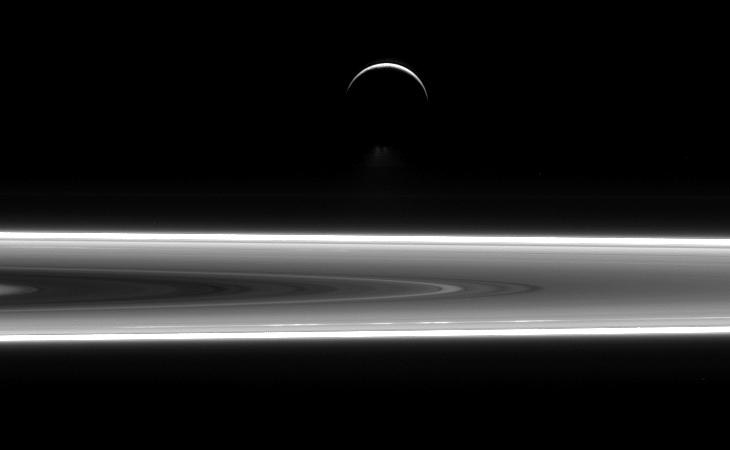
The very fact that there is liquid underneath that ice, so far from the sun, is what makes Enceladus one of our solar system’s most interesting bodies, and a target for future missions. The transport, binding, and catalyzing of elements into molecules takes place readily in liquid water, and is considered the prime factor in the development of life; things gotta mix. Liquid water not only needs a certain temperature, but a certain pressure, otherwise water exists either as ice or vapor. When we look at exoplanets around other stars, we’re looking for planets of a certain size and a certain distance from the star, to not only maintain the necessary temperature, but also to attract an atmosphere dense enough to keep water in place for billions of years. Mars was a little too small, and lost most of what water it had because the atmosphere got too thin to keep the moisture and it, literally, wafted off into space. Comets have ice that sublimates directly into vapor because there’s no atmosphere to speak of.
Enceladus, however, is different. We have to extrapolate everything about it from distant observations, but what we have now indicates that both radioactive decay in the core and the strong tidal influences of Saturn and other nearby moons keeps the rocky core hot – hot enough to maintain liquid water underneath a shielding layer of ice, melted from within rather than from the distant sun. What this means is that this moon of Saturn might be a self-contained ecosystem, capable of developing and supporting life completely underneath its thick ice mantle. It’s a long shot, of course, but a handful of both Saturn’s and Jupiter’s moons with similar conditions are the best chances we have of seeing extraterrestrial life.
Not that it would be easy. The frozen crust of Enceladus is estimated to be about 30-40 kilometers thick, or 19-25 miles. Unless we devised some method of negotiating down through one of the cracks that allow the geysers seen in the photo, we’d have to have a probe that could melt its way down through all that, which is a serious amount of energy. It would also have to avoid any contamination of the ocean beneath, and leave some kind of antenna or transmitter on the surface since no signal would be able to be sent from the probe beneath that much ice. The entire prospect is a massive physics exercise.
And just as a bit of trivia, Enceladus is only 500 km across, in comparison to our own moon’s diameter of 3,500 km, and thus possesses a commensurately lower gravity. Most of the water vapor escaping out through those cracks doesn’t remain near the moon’s surface, but instead forms Saturn’s E-ring – wispy, near-invisible, and stretching out many times the diameter of the rings we can see from Earth.
This highlights some of the accomplishments of the Cassini probe. None of this information has been provided by direct contact, and even visually, there’s only so much that can be determined from looking at the surface. Since its arrival in orbit around Saturn in 2004, the probe has been vastly expanding our knowledge of the ringed planet and its abundant collection of satellites. The composition of Enceladus, among many other aspects of the probe’s mission, has been interpolated from gravitational measurements and observations of orbital eccentricities; the floating ice crust, for instance, appears to be moving too much to be anchored to any solid surface beneath. Check out NASA’s pages on the Cassini mission for more info, including this one of Enceladus images, and Wikipedia’s page on Enceladus is remarkably detailed.
And another bit of trivia, because I’m a photographer. The image above is at or near full resolution (depending on your monitor settings) – if you want a closer or more detailed look at the geysers, too bad. The optical camera on Cassini is a mere one megapixel, which seems ridiculous to us now, but the probe was launched in 1997, and designed long before that; the digital options for consumers at that time weren’t significantly better, and certainly not affordable. If you’re curious, see this page for more details on how imagery in space probes is handled.
There are some more observations about related topics to come, but this is all I have time for right now. Check back shortly.




















































